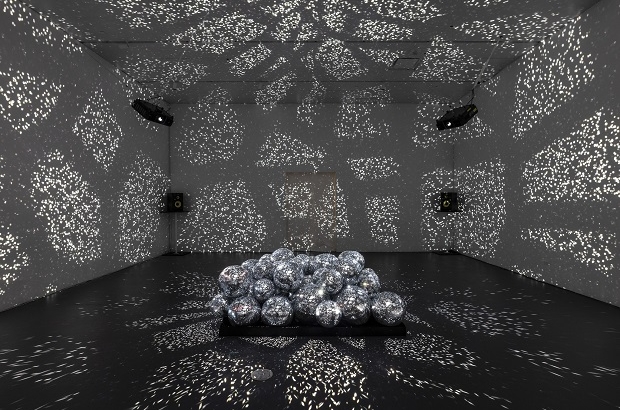- Daily & Weekly newsletters
- Buy & download The Bulletin
- Comment on our articles
Exploring the limits of outer space in digital art show at Namur’s Le Pavillon
While outer space continues to captivate mankind, human activity is also disrupting and threatening the planet and its ecosystems. This contradiction lies at the centre of the new KIKK exhibition Stellar Scape at Le Pavillon in Namur.
The permanent space dedicated to digital and creative arts is a fitting venue for the interactive and immersive projects presented by 20 international artists and scientific researchers. The futuristic building originally served as Belgium’s pavilion at the Milan World Fair; its occasionally unwieldy and echoey interior spaces serving as a backdrop for temporary artistic shows that explore cutting-edge digital creativity.
Run by Kikk, organiser of the renowned annual international festival showcasing digital culture, it specialises in curating accessible exhibitions that appeal to technophobes and geeks alike, young and old.
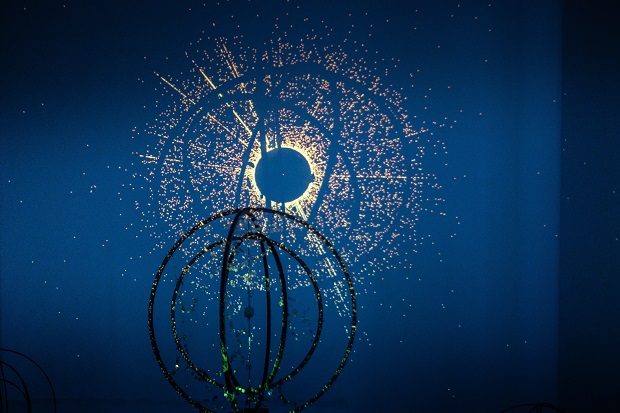
The aim is always to demystify digital advances and explore the challenges facing society. This latest show, occupying the realm of sci-fi, takes viewers on a deep dive into the world of astronomy and space adventures. Intersecting art and science, some projects are the result of artistic residencies and scientific collaborations, including the University of Namur.
For co-curator Jos Auzende, Stella Scape is also an invitation to Captain Future, an imaginary character in the possession of super powers that she created at the Paris digital arts centre Gaîté Lyrique. He serves as a guide for visitors of all ages: extending a hand for a voyage of discovery to unknown planets and constellations.
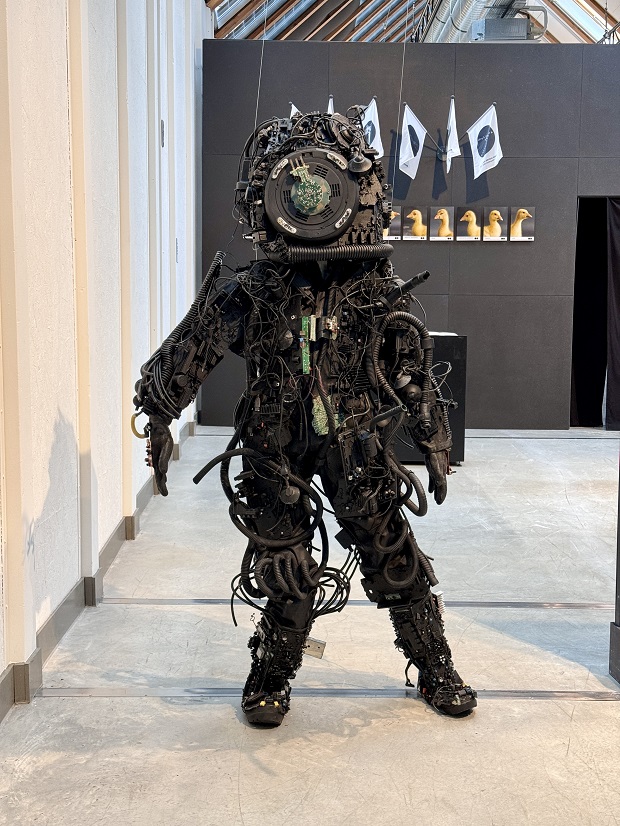
In the opening section, a series of works include a striking robot (pictured) created by Kongo Astronauts. The Kinshasa-based artist collective cast a critical eye on space exploration by presenting the space explorer in a golden suit littered with digital detritus.
German artist Agnes Mayer-Brandis ventures into science and fiction with her Moon Goose Colony project, inspired by Francis Godwin’s 17th-century novel, The Man in the Moon, in which the protagonist flies to the Moon in a chariot pulled by ‘moon geese’. In her documentary film, she details raising 11 moon geese, giving them astronauts’ names, and training them to fly before taking them on expeditions to Moon-resembling habitats. Mayer-Brandis teaches this endangered species how to find safer migratory routes to the moon which avoid space junk.
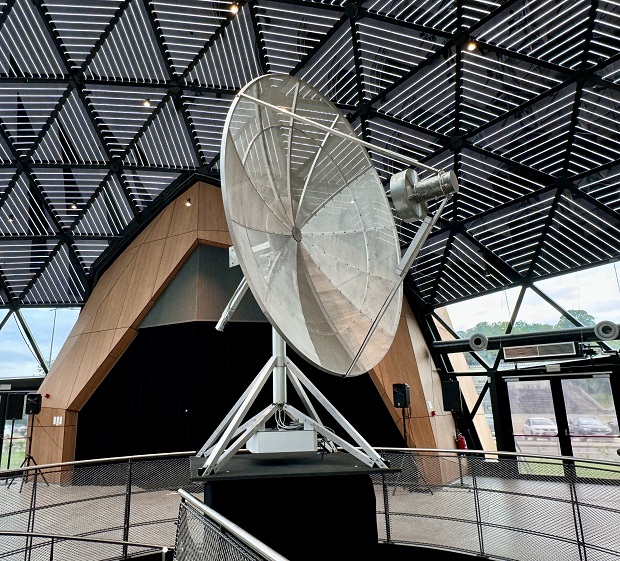
The pavilion’s atrium space houses two installations by Berlin artist duo Juliane Götz and Sebastian Neitsch (Quadrature). Their arresting installations straddle the borders of art and science and digital and analogical technology. For instance, CREDO (Cosmic Radio Engine for Delusional Observations; pictured) picks up extraterrestrial life and analyses cosmic sounds, its eerie bleeping resonating around the interior.
The sonar installation asks the question: ‘Are humans the sole beings in the universe?’ Neitsch explains that in reality it never actually finds aliens. “When you start looking for another civilisation, you only have one example, which is us.” Employing AI, the telescope picks up radio trash, human-created data.
Their second work resembles a photo booth, but turns out to be Scope (Space craft oracle for personal enlightenment). Visitors enter their birth date into a screen, while outside – like a reel of ID photos – their individual horoscope spools out, a personality summary that tends to be pretty spot on, despite or because it is delivered by the colony of military and intelligence satellites that rove above.
“Stars were a given thing and our history is based on this fixed constant of the sky, for calendars, for navigation… and now we are about to change it,” points out Götz.
“Over past decades we looked up to the skies for answers; the mystery was in trying to decipher the conundrums of life,” she says. This installation “is mainly about the human hubris and narcissism to think that the universe is wanting to tell us something… and wanting to change what is already there.”
Neitsch interjects: “The amount of satellites and objects that are launched[in space] is exponentially growing. In 2015, there were about 1,000 active satellites and now we have around 40,000,” he says, while adding a chilling projection. “It is thought that in the next 20 to 30 years, we will see more satellites than stars in the night sky.”
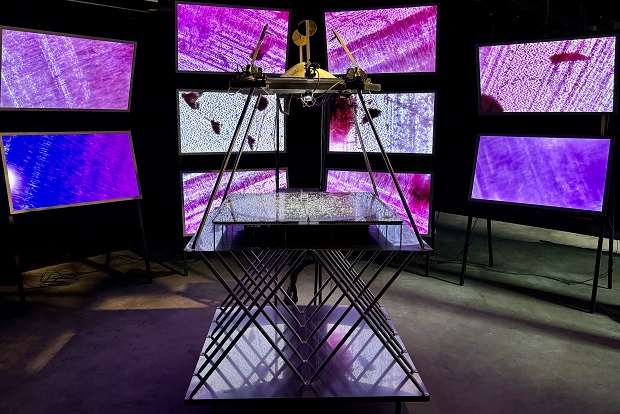
Down in the Playground, a space without natural light, six projects are gathered, including Lucien Bitaux's Nadir (pictured). The Picture Elements Explorer is a kind of camera, a space probe that studies rock particles to reveal the paradoxes in astronomical imagery.
Brussels-based Bulgarian artist and researcher Pepa Ivanova shows her installation WARMTH. The tactile work consists of a series of illuminated glass squares that recreate an imaginary experience of touching the sun.
“I wanted to have the feeling of being close to the sun and the experience of walking on the surface,” she recounts. Each square corresponds to a different phenomenon and they are accompanied by a soundscape; a reflection of the frequencies on the sun that extend to the earth “and feed our pollution”. As the visitor moves around the visually beautiful installation, the sound tracks their movement.
While her projects vary, she tends to focus on frequencies and what lies between them. “I didn’t want to be too techno-centric in this one, the technical part is there, but hidden underneath.”
There’s an interactive aspect to the majority of the works in the exhibition, some providing a completely immersive experience to transport the visitor to a state of introspection and reflection.
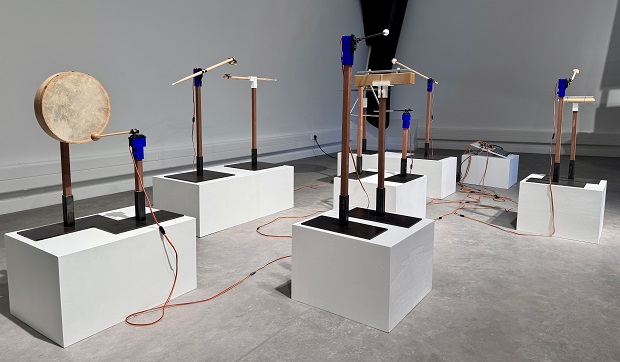
In the Stella Lab (pictured), research and innovation are the key elements, bringing together Belgian and European companies active in the field of astronomy. Among the 12 installations are prototypes of A.M.O.S, Aerospacelab, Aldoria and Latitude.
The Pavillon, which opened in 2021, is perched atop the esplanade of Namur’s ancient citadel, easily accessible via a new cable car that links it with the Walloon capital’s city centre.
Stellar Scape (curated by Marie du Chastel and Jos Auzende)
Until 26 January
Le Pavillon
Route Merveilleuse 65
Namur
Photos: (main image) Kyle McDonald; ©Alessia Sanna; Kongo Astronauts 3 ©BE CULTURE; Lucien Bitaux ©BE CULTURE; Stellar Lab ©BE CULTURE












